The core design of a meat grinder has stayed the same since Karl Drais invented it in the 19th century. So, for the next meatball you pleasantly eat, remember the name of the person who started it all.
But you might not want one because you don’t know precisely how a meat grinder works properly. Follow the steps below and buy a meat grinder for a healthy, tasty home-cooked meal.
I’ve also included a brief yet handy buying guide and some essential tips. Hope you’ll like it.
How Does a Meat Grinder Work Properly?
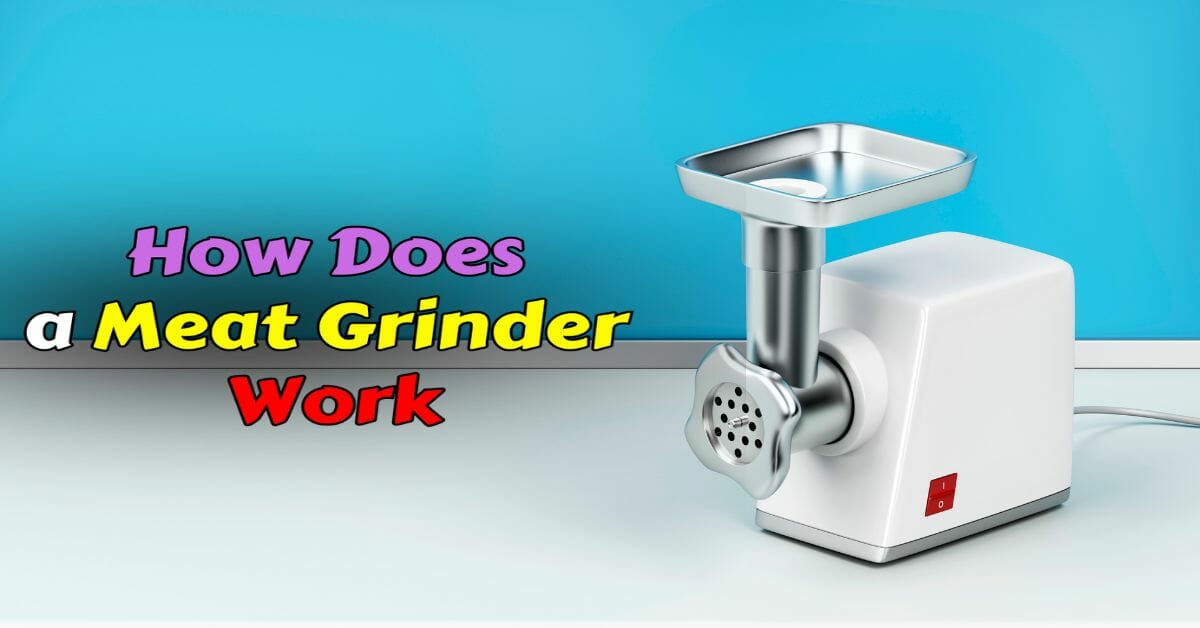
The components of the meat grinder will work well if you use them correctly. Yeah, seems like a simple process of pushing down, hammering meat into the tube, and collecting the ground meat from the lattice. Let’s find out the proper working principle of a meat grinder.
Step 1. Prepping the meat before grinding
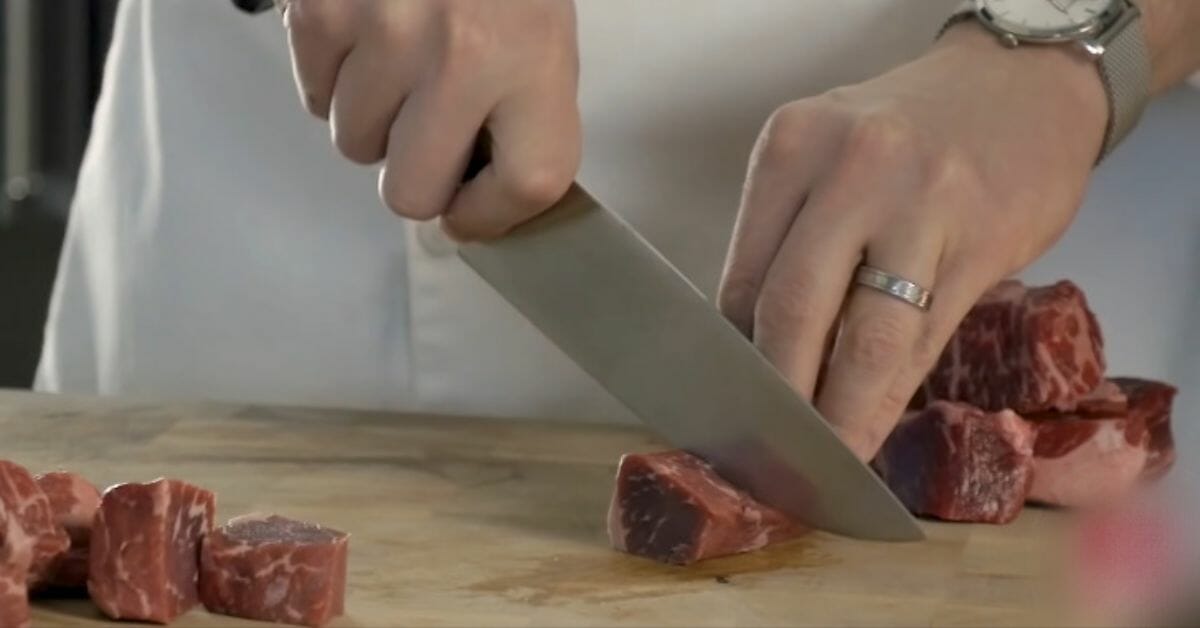
Take an enormous piece of meat and clean it with water. Then, cut off excess fat and give it a gentle wash again. Use a part of a towel to wrap the meat for a couple of minutes. Then, place it in the freezer to cool down.
I cut my meat to the right size and wrapped it in silver foil to sanitize it hygienically. Then, I put it in the freezer to cool down.
Please note that you’ll need to cut the meat slices according to the size of your meat grinder’s feeding tube.
The meat must cool down so it doesn’t stick to the grinder’s wall. If you can, freeze the grinder blade, too. It’ll enhance the grinding speed and efficiency.
Step 2. Meat grinder assembly
Before you start, let’s assemble the meat grinder. Read the user manual and follow the instructions.
Step 3. Putting the meat into the feeding tube
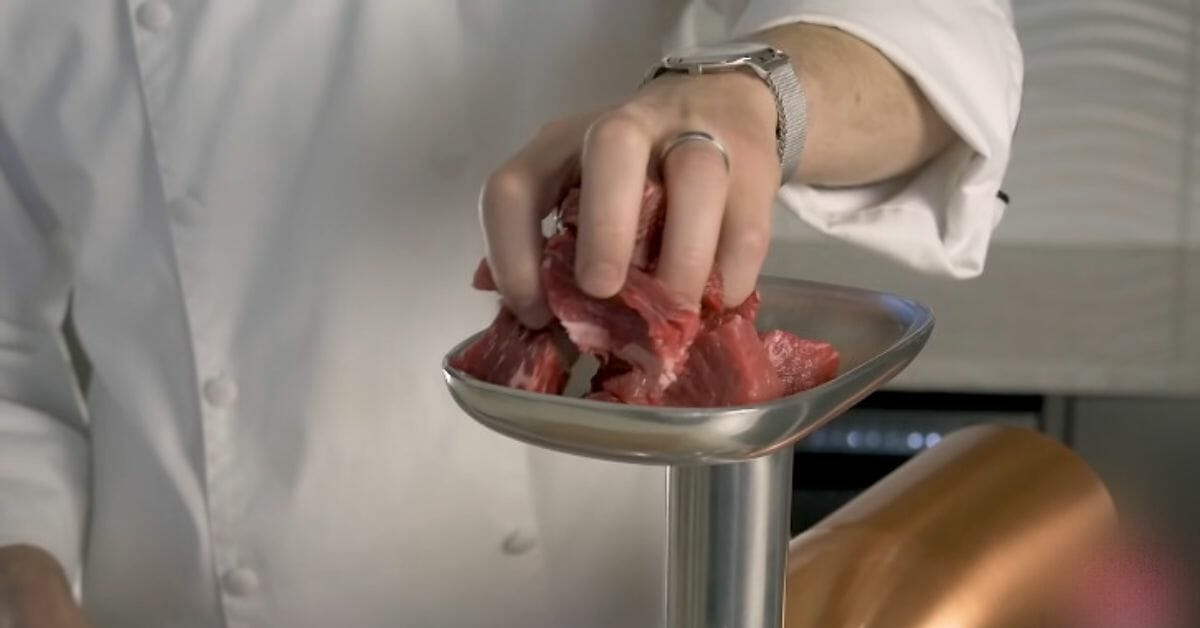
Now, remove the semi-frozen meat from the freezer and place it in the feeding cylinder. Please ensure the beef is sliced into small enough pieces for proper grinding.
Step 4. Slice and grind

Once the meat reaches the lower extruder, the blade slices the nest, and the ring screw pushes the meat out through the lattice/grinding plate. Don’t forget to place a bowl to gather the ground meat.
Step 5. Change the lattice/ grinding plates if necessary
You should grab a few different sizes of lattices. So you can get grinding portions of different sizes that fit your needs. It could be a meatball or sausage shape.
Step 6. Finish up the grinding in a hygienic manner
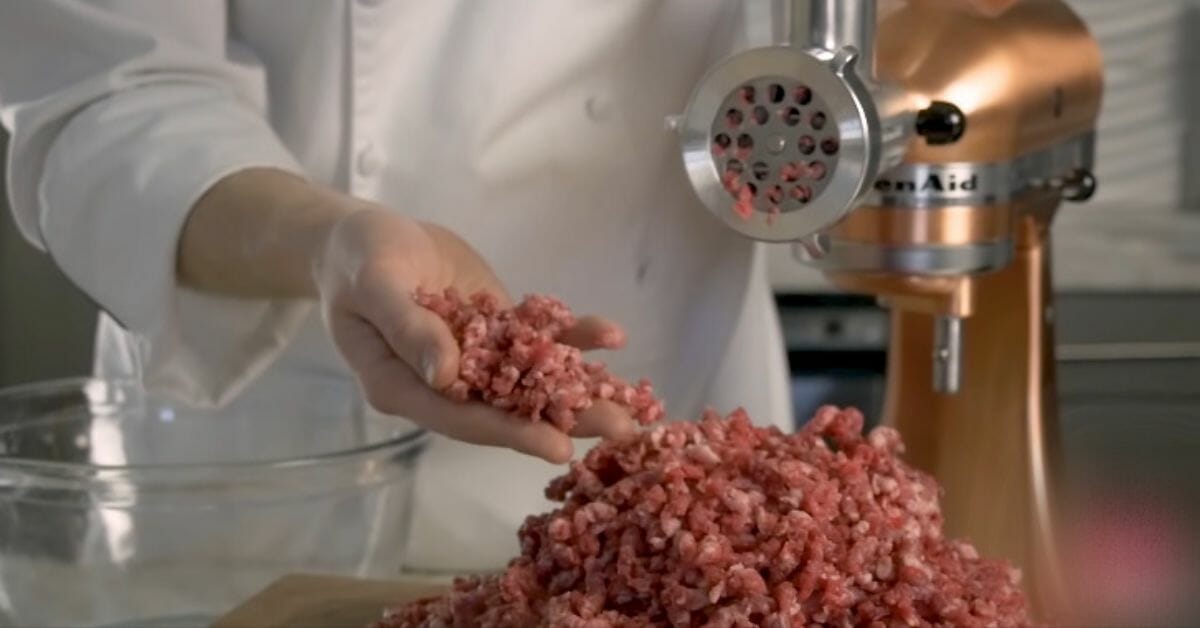
Once you’re done with the meat grinder, clean it thoroughly. Ensure no meat residue is left in or outside the grinder.
But how do I clean the inside chamber of the meat grinder?
I grind bread through the meat grinder for easy cleaning. It’s useful and prevents your inner components from getting wet every day.
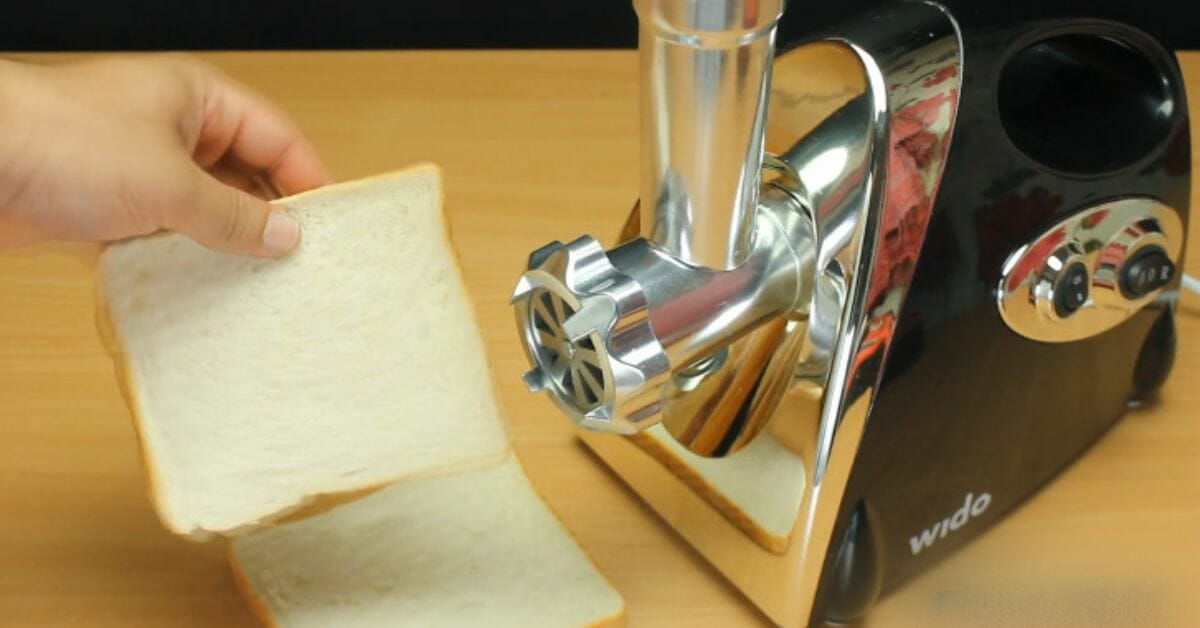
Manual meat grinders are easy to clean thoroughly. You can at least wash them once a week with soap and water.
However, the electric meat grinder requires systematic cleaning stages. Please follow the manufacturer’s recommendations in the user manual or watch the video below.
What to Consider Before Buying a Meat Grinder
The right size
Every meat grinder comes with a size label.
| Meat grinder size | Lattice/ disc-shaped grinder plate diameter/ meat grinder exit plate |
| 5 | 2 ⅛ |
| 8 | 2 ½ |
| 12 | 2 ¾ |
| 22 | 3 ¼ |
| 32 | 3 ⅞ |
The chart shows the typical size of meat grinders best for homes. The bigger the meat grinder, the larger the feeding tube. You can change the exit grinding plate type to make meatballs, sausages, etc.
Make sure it has a reverse function.
Someday, meat will get stuck in your meat grinder. So it’s essential to see if your meat grinder, especially those electric ones, has a reverse motor function. Without the feature, it’ll be hard to unclog the meat grinder.
Must look for the sausage attachment
You’ll want to make sausages at some point, so make sure your chosen meat grinder model offers a sausage stuffer or sausage attachment option.
Nothing but stainless steel
I’m talking about the grinder blade. Do not settle for anything less than a stainless steel cutting blade. Stainless steel blades stay sharp for a long time, are hygienic, and are less prone to rusting over time. This durable and sharp cutting blade is the reason for the ground meat and vegetables you crave.
Never compromise on durability.
Durability was never an issue for manual meat grinders. However, manufacturers use plastic frames as a cost-cutting incentive with electric meat grinders.
I’m not saying plastic meat grinders are bad. Besides, it’s mostly the outer shell; the inside structure is aluminum or steel. Still, if you want that ultimate meat grinder, go for the cast aluminum build.
Should you go for the manual or the electric meat grinder?
If you want something simple, durable, dependable, and operating without a power source, the manual meat grinder is your best choice.
But if you don’t like stressing out your arms because there is a lot of grinding to do, settle for an electric meat grinder.
Want a meat grinder for your home or your restaurant?
If you need a grinder to make meatballs, sausages, ground meat dough, etc., at home, get a low-powered electric meat grinder.
But for restaurants, you can’t settle for anything less than a commercial electric meat grinder. They are big and offer faster grinding power at a ridiculous speed.
Meat Grinder Price
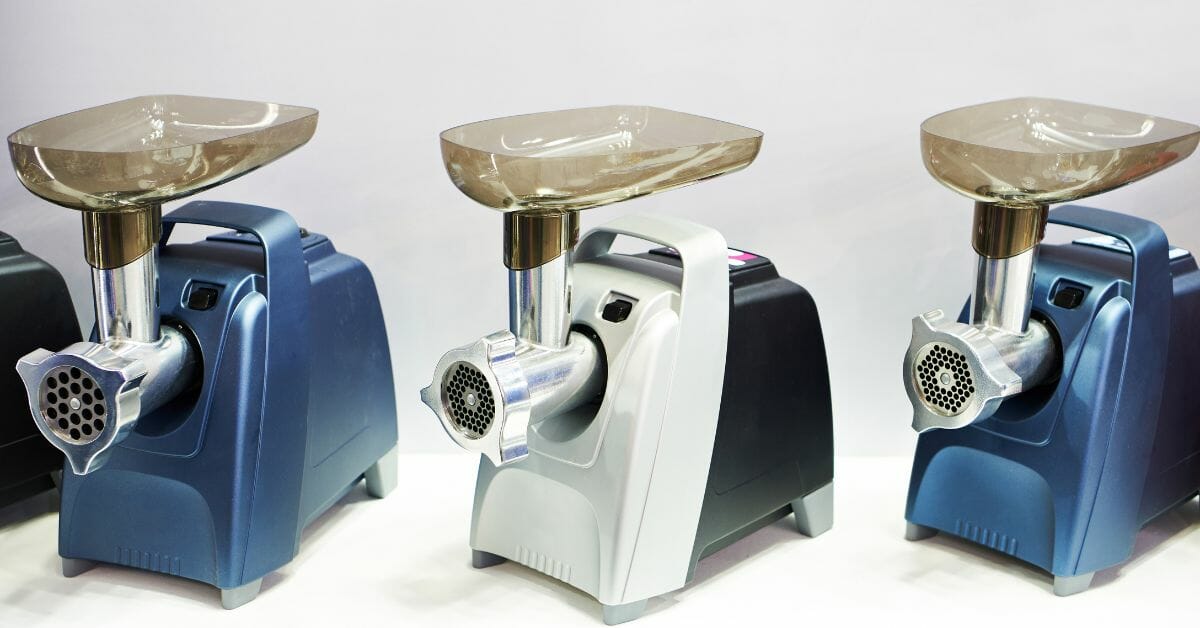
Price is an essential part of them all. The cost will vary from model to model. Base models are focused on budget buyers, whereas the top models tend to be for commercial use.
I suggest deciding on a budget and then browsing through to see your budget grinder features. Try not to be too stingy with the price because quality products cost more.
Meat grinder components
Although different types of meat grinders exist, their core design and mechanism remain the same, with a few tweaks and upgrades, from build quality to the blade’s design.
The operating methods are different, though. The manual meat grinder requires your arm to rotate, while the electric meat miner is just a switch press away.
To understand how a meat grinder works properly, we must identify how each component works.
Motor
Let’s remove the apparent difference-maker first. You’ll see a motor with an electric miner only. Its rated power ranges from 300 to 500 watts. More wattage means more torque from the motor, which means more grinding power in a short time.
Meat pan/ tray
The tray sits on top of the meat grinder, so you can’t miss it. Ensure the plate is made of stainless steel so it won’t go bad over time, rust, chip, or dent.
The meat access cylinder
There is a “T” shaped round cylinder below the tray to insert the meat.
Ring screw
The ring screw acts as a mechanism (also known as the extruder) to take the meat out. Once the meat reaches the bottom tube, the ring screw gets pushed towards the grinding plate.
The cutting blade
The cutting blade is located at the end of the extruder. It is made of stainless steel, so it won’t rust over time.
Lattices/ Grinding plates
It’s a small, rounded, metal or stainless steel plate with holes. Once the meat is adequately sliced and pushed by the extruder with the help of the O’ ring screw, the meat comes out of the lattice in pieces.
The hole size differs depending on the type of meat you’re grinding. Three sizes are available.
Large: 0.6- 0.8 cm.
Average: 0.4-0.5 cm.
Small: 0.3-0.35 cm.
There is also a beef stroganoff up to 3 cm with elongated slots.
Stuffer tool for sausages
If you wish to prepare some sauces, then this sausage stuffer tool needs to be attached to the ring screw.
Meat stiffer
It’s a plastic stick that shoves the meat into the feeding tube of the meat grinder.
Other accessories
There are different types of nozzles for processing vegetables and fruits. You can make sausage or meatball shapes or grind out a few doughs in short crust shapes.
How to sharpen your meat grinder blade?
Different parts of a meat grinder could cost you hundreds of dollars. So instead of replacing them, why not re-sharpen the meat grinder blade and those plates?
Some things are easy to understand by watching rather than reading about it.
How to Store Your Meat Grinder?
You must properly store your meat grinder, whether it’s for a day or a few months. If you might not use it for months, applying a layer of oil coat will protect it from rusting and oxidizing.
Please use food-grade oil. Don’t use oil that is not consumable.
You can polish the oil using your hand or with a pastry brush. However, I use a spray bottle to apply oil because it’s faster. I like to lubricate my meat grinder thoroughly.
Once you’ve lubricated the metal parts, including the meat tray and pusher, wipe them thoroughly with a cloth. I use a microfiber cloth, just to let you know.
Once they are appropriately wiped, I wrap each part of the meat grinder with cotton clothes. However, I pack them up in polythene or plastic bags.
You can also try burying each part of the meat grinder in a pile of rice. The rice soaks up moisture, preventing damage from rust. It also disinfects, protecting your meat grinder from microbial and bacterial buildup.
Keeping the grinder buried for a long time could build up rice films. Wash it off with bleach before using it again.
Sometimes, I leave my meat grinder in the refrigerator the day before use—the cold blade slices through the meat like butter.
Hey, here’s a friendly tip: If you ever drop a phone that isn’t waterproof in the water, bury it in rice for half an hour.
What is an Electrical Meat Grinder?
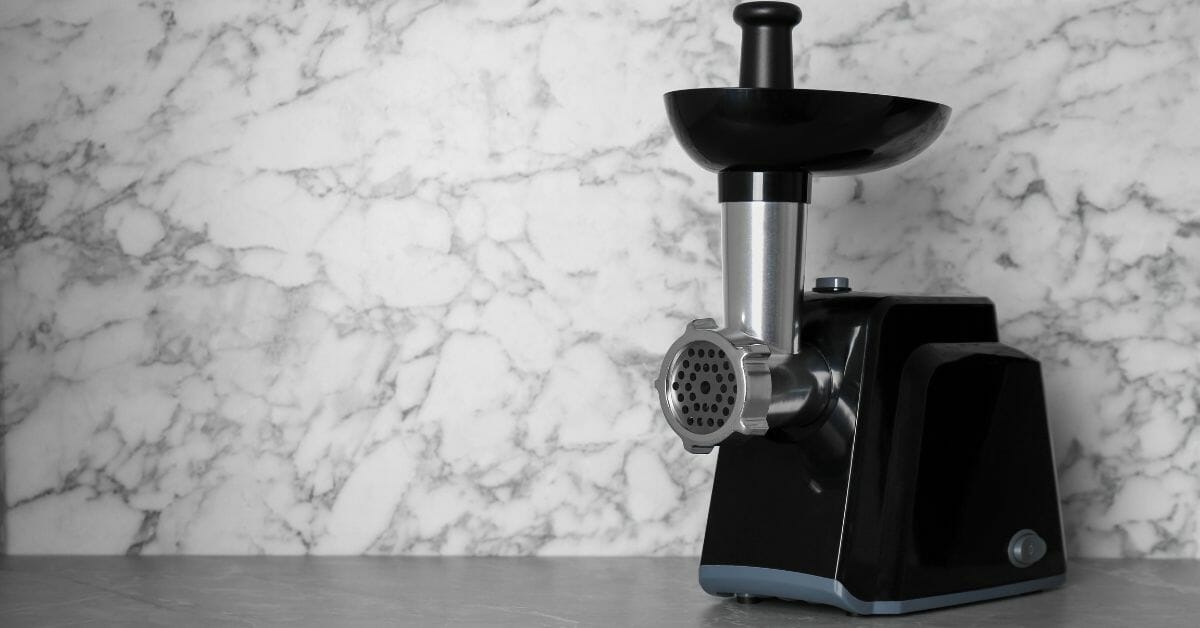
Are you tired of rotating your arms to grind your meat? Get an electric meat grinder. It’s the same as the manual meat grinder but uses a motor to grind the meat.
The electric meat grinder is faster, more reliable, and expensive than the manual. Plus, you can grind a large portion of meat without burning out your arms.
I don’t recommend a manual meat grinder unless you are short on cash and don’t need to grind a lot of meat within a specific period.
But why an electric meat grinder?
Let’s say the meat you are cutting down has bones hidden inside. You can use a manual meat grinder to cut and grind it, but that’ll take nearly maximum effort without much efficiency.
But an electric-powered meat mincer can slice and grind out those types of meats quickly.
Electric meat grinder problems
Unlike the manual meat grinder, an electric meat grinder has its own meat grinding limit. Gears separate the power delivery systems. So if you try to operate your meat grinder in overdrive, it might fail.
A broken meat grinder is hard to repair, and most of the time, you’ll need to throw it in the trash and buy another one. But if you replace the damaged part with new spare parts, it’ll become usable again.
Another standard troubleshooting step for the electric meat grinder is the gear system malfunction. If you face this sort of dilemma, don’t stress. Just relax and find solutions in the owner’s manual guide. Or you could DIY the answer.
Electric meat grinder pros
Hygienic: Meat is safer after cooking. But what about before? Raw meat could contain harmful bacteria and microbes, which could be an issue for you. An electric meat grinder allows you to grind with minimal to no contact with the meat. It’s also faster, which slows the degradation process due to less heat exposure from warm air.
Power: It’s like both sides of the coin. Limited motor power is a disadvantage, but the maximum power delivery is an advantage. The ability of a manual meat grinder depends on your strength. Now let’s say you’re not very strong. That’s where an electric meat mincer shines.
Their power is enough to crush and grind typical-sized meat promptly. Before choosing your next meat grinder, look for the higher wattage, horsepower, and stainless steel material for faster meat grinding pounds each minute.
Plug & Play: Unbox your new electric meat grinder and assemble it as instructed. Now plug in the grinder and let the mincing begin. You don’t need to bolt down the surface, and no need to shove the meat into the grinder. The electric meat grinder has a roller plate that easily pushes the meat through the machine.
Efficient & Effective: An electric meat grinder’s most significant selling point is how fast it can grind through cubed meat. You can easily grind big portions of tough meat from games like elk and deer. Or you could grind down one batch after another of chicken, pork, and beef in no time.
Industrial design: A manual meat grinder cannot be used on an industrial scale. However, an electrical meat grinder is designed to meet commercial standards and be efficient.
Electric Meat Grinder Cons
Plastic gears: Don’t buy electric meat grinders with plastic gears. They will go bad pretty fast if you keep grinding meat to the limit. Trust me, the repair cost and long-term outcome aren’t worth it.
A tad bit pricey: It’s a no-brainer that the electric meat grinder costs more than the manual meat grinder. Please don’t go for the cheapest option. It will reduce overall performance and consistency.
Lacks a compact design: One of the most significant drawbacks of an electric meat grinder is the need for a power source. You must grab the manual meat grinder for outdoor activities, like long hunting tours, picnics, hiking, camping, etc.
What is a Manual Meat Grinder?

A manual meat grinder is the right choice if you use it occasionally. But I think it’s the right choice for beginners to understand how a meat grinder works. Besides, you can’t say no to working out your arms in exchange for some delicious meatloaves.
A manual meat grinder is the only option if you don’t have a power source nearby. And you need to constantly move your culinary setup from urban areas to the most remote places. Owning manual and electric meat grinders is worth the money you spend in the long run.
And who can say no to the sturdy build quality, simple mechanism, and reliability of a manual meat grinder? Did I forget to mention a slight curl of biceps on the side?
But if time and strength are not your strongest side, please don’t buy the manual meat grinder.
Manual meat grinder pros
Portable: Unlike the electric meat grinder, a manual meat grinder requires no power input source. So you won’t have to worry about a power source for the meat grinder to work in remote areas, like hunting or camping trips.
Besides, it’s not as heavy as those electric meat grinders. So expect easy portability from place to place. It takes up less space to operate compared to the electric meat grinder.
The price: Another big selling point of the manual meat grinder over an electric meat grinder is the affordable price tag. Those who are new or low on a budget should consider buying a manual meat grinder.
Electric bill: Depending on the model, an electric meat grinder can draw 150- 500 watts of power. Over time, this power consumption will add up and cost you much more than anticipated.
Manual Meat Grinder Cons
Not very convenient: The absence of a motor in a meat grinder has some disadvantages. You will only have your arm’s power to rely on. So it’s impossible to match the exact precision and control of each portion of meat.
Risk of catching diseases: I recommend using surgical gloves to avoid infectious diseases from raw meat. The risk increases when the raw meat stays exposed to hot and humid conditions for longer. And you can’t prevent the warm kitchen. But there is a way. You can grind a large batch of meat after proper refrigeration.
Muscle stress: I remember grinding a couple of pounds of pork for Thanksgiving. Even a hunk like me got tired, and my right biceps were on fire. Don’t buy the manual meat grinder if you have to grind a large portion of meat daily. It’s a more suitable option for special occasions.
A Few Frequently Asked Questions About the Meat Grinder
What is a good meat grinder for a home?
It depends on the meat grinding volume you’re looking for. If you plan to use the meat grinder 2-3 times a week, then go for the electric meat grinder.
And those occasional users’ best bet is the manual meat grinder. I like manual meat grinders because they cost less, are easy to transport, and are less prone to breaking down. Besides, there is no power demand to operate. Cool.
What happens if there are bones in the ground meat?
Don’t worry. The meat grinder’s blade is strong enough to crush the bones. But it can only slice through softer meats like chicken, waterfowl, rabbit, ducks, and other small birds.
Slicing becomes easier when the bones cool. But remove them from the refrigerator before they freeze and become a piece of steel. Now, that is bad for your meat grinder’s blade.
Do I even need a meat grinder?
I don’t see why not. You love meatballs, and your kids probably love sausages. Of course, you can buy frozen sausage and meatballs from the supermarket. But which is better, grinding fresh meat to make them or buying processed food at an extra cost?
What is the right size for the meat grinder?
The size of the meat grinder depends on two things. The plate/tray size is on top of the feeding tube and the plate where the ground meat comes from. So you must read the specifications exceptionally well before buying the meat grinder.
Wrapping Up
If you don’t have a meat grinder yet, consider getting one. Why? Because you can make cookie dough, grind meat and vegetables, and make meatballs and sausages. Since you already know how to make a meat grinder work properly, it shouldn’t be a poor investment to experience the miracles of meatballs, my friend.

